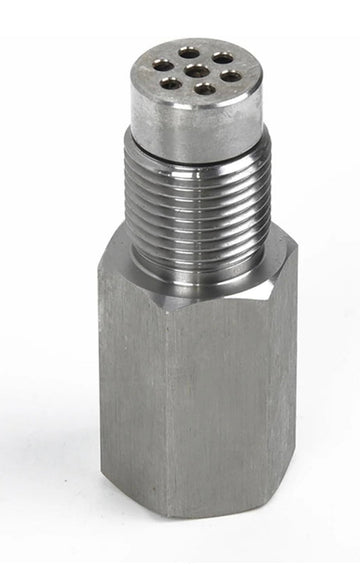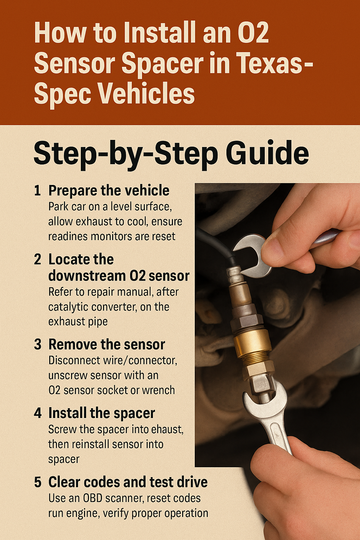Summary: O2 sensor spacers are popular among car enthusiasts and tuners who want to reduce or eliminate check engine lights (CELs) triggered by aftermarket exhaust modifications. But do they actually help pass emissions tests? In this guide, we explore how O2 sensor spacers work, their effectiveness in emissions compliance, and what you need to know before relying on one.
Table of Contents:
-
What is an O2 Sensor Spacer?
-
Why Do Vehicles Fail Emissions Tests?
-
How an O2 Sensor Spacer Works
-
Can It Really Help You Pass Emissions?
-
Types of Emissions Tests
-
Legal Considerations
-
Installation Tips
-
Spacer Types and Effectiveness
-
Alternatives to Using a Spacer
-
Final Verdict
-
FAQ
1. What is an O2 Sensor Spacer?
An O2 sensor spacer is a small device installed between the oxygen sensor and the exhaust pipe. It moves the sensor slightly out of the direct exhaust stream, which reduces the amount of exhaust gas the sensor detects. This can trick the vehicle’s ECU (engine control unit) into believing the catalytic converter is functioning properly, even when it isn’t—or isn’t present.
2. Why Do Vehicles Fail Emissions Tests?
Vehicles fail emissions tests primarily due to:
-
Faulty or missing catalytic converters
-
Bad O2 sensors
-
Poor fuel-air mixture
-
Emission-related DTCs like P0420/P0430 (Catalyst Efficiency Below Threshold)
3. How an O2 Sensor Spacer Works
When an O2 sensor is moved out of the exhaust stream, it reads a cleaner exhaust sample. The ECU sees the reduced oxygen fluctuation and assumes the catalytic converter is still doing its job. This can prevent the triggering of codes like P0420, which signal a catalytic inefficiency.
4. Can It Really Help You Pass Emissions?
Sometimes, yes—but it depends.
O2 sensor spacers may:
-
Prevent CELs from appearing due to cat inefficiency
-
Allow OBD-II readiness monitors to set
However, they do not reduce actual emissions. In states or countries with:
-
OBD-II plug-in tests (checking for DTCs and readiness): Spacers can sometimes help.
-
Sniffer tests (measuring tailpipe emissions): Spacers won’t help if your emissions are actually too high.
-
Visual inspections: Spacers won’t hide missing or tampered catalytic converters.
5. Types of Emissions Tests
-
OBD-II Scan: Checks for codes and system readiness. Common in many U.S. states.
-
Tailpipe (Sniffer) Test: Analyzes exhaust gases. Common in older vehicles.
-
Visual Inspection: Checks for all emission components being intact.
6. Legal Considerations
Using an O2 spacer to defeat emissions controls may violate local, state, or federal emissions laws (e.g., the EPA's Clean Air Act in the U.S.). These devices are often sold "for off-road use only."
Penalties may include:
-
Fines
-
Failed inspections
-
Vehicle registration denial
7. Installation Tips
-
Choose a high-quality spacer made of stainless steel or plated steel
-
Install on the downstream (post-cat) O2 sensor
-
Use thread anti-seize compound
-
Make sure the sensor wires are not strained or twisted
8. Spacer Types and Effectiveness
-
Straight spacers: Basic design, limited effectiveness
-
Angled spacers: Help with fitment in tight spaces
-
Mini catalytic converter spacers: Contain a small catalyst core to more convincingly mimic catalytic function (more effective)
9. Alternatives to Using a Spacer
-
Replacing a faulty catalytic converter
-
Tuning the ECU to ignore rear O2 sensor input (for off-road or race use)
-
Using high-flow catalytic converters that maintain emissions compliance
10. Final Verdict
O2 sensor spacers can help prevent certain emissions-related codes from appearing, which may allow a vehicle to pass an OBD-II scan-based test. However, they do not reduce actual emissions, and their use may be illegal depending on your jurisdiction. Always check local regulations and consider more compliant alternatives for long-term reliability and legality.
11. FAQ
Q: Will an O2 spacer guarantee I pass emissions? A: No. It may help avoid a CEL, but it won’t guarantee passing, especially under visual or sniffer tests.
Q: Is using an O2 spacer legal? A: In most cases, using it to defeat emissions controls is not legal on public roads.
Q: Can I install it myself? A: Yes, if you’re comfortable working under your car and have basic tools.
Q: Do mini cat spacers work better? A: Yes, they tend to be more effective at mimicking catalytic function.
Q: Will my car run better with a spacer? A: It won’t improve performance, but it may prevent a CEL from triggering.
For related topics, check out:
-
"How to Fix a P0420 Code Without Replacing Your Catalytic Converter"
-
"What’s the Difference Between High-Flow Cats and Catless Downpipes?"
-
"Top 5 O2 Sensor Spacer Designs for Tuned Vehicles"
Need a high-quality O2 sensor spacer? Browse our collection at Ghaly Motor Parts today!

![ Fix P0420 Fast: Do O2 Sensor Spacers Really Work? [Legal Tips Inside]](http://ghalysmotorparts.com/cdn/shop/articles/ChatGPT_Image_Oct_10_2025_10_40_32_AM.png?v=1760118069&width=360)
![Do O2 Sensor Spacers Really Help Clear the P0420 Code? [Expert Guide]](http://ghalysmotorparts.com/cdn/shop/articles/ChatGPT_Image_Oct_9_2025_09_28_33_PM_654c1798-c0d4-428f-a5b6-f20b95661b54.png?v=1760129952&width=360)


